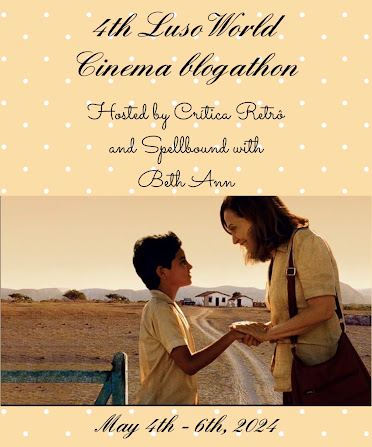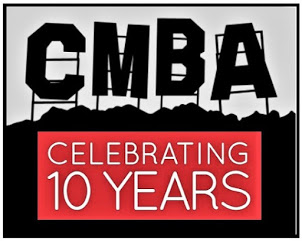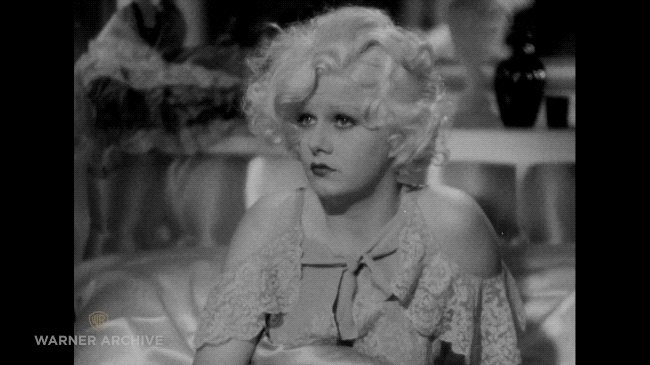
Ebenezer Scrooge has a bad feeling about this. Image: Sundance Now
The hottest-selling book of the 1843 holiday season was a hastily-written novella concerned with society’s treatment of the poor.
Yup, you guessed it: Charles Dickens’ A Christmas Carol sold 6,000 copies that season – not bad, considering it didn’t arrive in bookstores until December 17. They say it’s not been out of print since.
You likely have a favourite movie version of A Christmas Carol, but we think you may be interested in Scrooge (1935). This film, from Britain’s Twickenham Studios, was the first sound adaptation of Dickens’ novella.
Seymour Hicks stars as Ebenezer Scrooge, a sour man with disorderly hair and a soul as hard as cement. He has no patience for inefficiency or waste. Don’t ask him about the poverty-stricken; everyone knows if you’re poor it’s your own stupid fault.
Example: when two men arrive at his office seeking donations for the poor, Scrooge is immediately irritated. “Are there no prisons?” he growls. (He is likely referring to workhouses, often called “prisons”, where the poor worked in return for food and clothing.)
Scrooge further shows his exasperation by implying the situation could be solved by decreasing “the surplus population”.
This is the kind of person Scrooge has become.
You’re familiar with the story: On Christmas Eve, Ebenezer Scrooge is visited by apparitions who show him how his decisions have affected others and the inevitable outcome of those decisions.
It’s as grim as it sounds, and it unnerves Scrooge, a hardened man who eschews pleasantness. When he’s visited by the unseen spirit of his deceased partner, Jacob Marley, Scrooge cries, “Speak words of comfort!”
Marley’s reply is bitter: “Comfort? I have none to give.”

Scrooge can’t understand why the netherworld is picking on him. Image: ravepad.com
The film offers no comfort, either, and very little warmth. The air is frigid, and Scrooge himself is frosty to everyone.
Yet this is nothing compared to the metaphysical adventures in store that night.
It begins when Scrooge arrives home, and sees – or thinks he sees – an unearthly face in his front door. When he enters the house, he convinces himself that there are no ghosts and, just as he calms himself, all the servants’ bells in the house start to ring. This terrifies Scrooge, but also prepares him for Marley’s disturbing visit.
This film has a gothic horror feel. Director Henry Edwards uses shadow as much as dialogue to tell the story. Sinister silhouettes loom across walls, and darkness conceals secrets.
Take the scene where four thieves have looted possessions from recently deceased people. As they meet in a dark subterranean room to examine the loot, Edwards shows their faces in eerily-lit close-ups. These are people Scrooge disparages, but as he observes the little regard they have for human life, he starts to panic.
This is rich coming from a man who is not so different from them.

Bob Cratchit (Donald Calthrop) grieves over Tiny Tim. Image: Jim Hill Media
The movie is not without pathos. When Scrooge discovers Tiny Tim will die, he becomes distraught and begs the apparition to do something. The apparition responds with Scrooge’s own argument: “If Tiny Tim is to die, shouldn’t he just get on with it? Wouldn’t it be better to decrease the surplus population?”
Ultimately, Scrooge is a redemption story. Although Scrooge is rehabilitated, the most encouraging aspect is not his change of heart. It’s the apparitions’ understanding that something in him is worth saving – an unexpected message from a borderline gothic-horror flick.
Notes on A Christmas Carol (the novella):
- Click HERE for facts on the novella from Mental Floss.
- Click HERE for a list of film adaptations.
Scrooge: starring Seymour Hicks, Donald Calthrop, Robert Cochran. Directed by Henry Edwards. Written by H. Fowler Mear. Twickenham Film Studios, 1935, B&W, 78 mins.










Oh my gosh I’m freaking out a little. I LOVE this book (and, yes, the movies) but have never seen this one. 👻🎄❤️ Eek! Looks suitably creepy…
Haha! “Scrooge can’t understand why the netherworld is picking on him.”
LikeLike
This version of “A Christmas Carol” must have been really unnerving on the big screen back in the day. In fact, if I saw it in a theatre today, I would be a little afraid. I’m serious!
LikeLiked by 1 person
Actually, it wouldn’t have surprised me if audiences would have taken it into stride. I think today it would be more unnerving because we expect Christmas tales to be sentimental and full of technicolor images and lightness and air.
Tam
LikeLike
You’re probably right. I would be unnerved by the some of the cinematography. Some scenes are pretty creepy, even on the small screen.
LikeLike
Yikes. 😬 (Still going to watch it though…)
LikeLiked by 1 person
We’re watching it! Thanks for the recommendation. Interesting so far…like the creep factor. 😄
LikeLike
Isn’t Seymour Hicks a fab Scrooge? Have a merry Christmas day! 🙂
LikeLike
I am a huge fan of this movie. It really is very dark in tone and Seymour Hicks is just wonderful. This film has been on TV quite a bit here in the UK in the last couple of weeks and I would recommend it most strongly, nice to see someone writing about this film with such enthusiasm. Despite all the wonderful films they have inspired I still believe that the works of Charles Dickens are best enjoyed on the page.
LikeLike
I’m glad to hear this film is getting more air play in the UK. I first discovered it a few weeks ago in a budget set of holiday DVDs. I was amazed by Seymour Hicks. This film does have its detractors, but I think it’s my fave version.
As for Dickens’ work, you may be right. He’s an incredible chronicler if human nature.
LikeLike
Can’t get through the holiday without revisiting this tale. Always encourages the believe that everyone is worth saving, everyone. Have you seen the Muppets’ version? Anything Michael Caine is worth watching in my book… Happy Christmas!
LikeLike
I love the Muppet version! I especially like Michael Caine’s performance. He doesn’t ham it up…he acts as seriously as he would if his co-stars were human.
LikeLike
This sort of reminds me of how people have taken Grimm’s Fairy Tales as sweet and innocent tales when they were really written to be much more gruesome. People in the Victorian age weren’t afraid of gore and blood and they didn’t compartmentalize them as we do today (i.e., children’s books and Christmas tales are never gory, etc). Nice review.
Tam
LikeLike
Thanks for dropping by. Yes, those tales have been fairly sanitized today, haven’t they? And also designed for mass marketing.
LikeLike
I’ve never come across this on UK TV – just checked and it has only been shown on Talking Pictures TV, which isn’t available in my area unless you have satellite TV, and I’ve got cable. I did see it a few years ago online but, as a huge Dickens fan, would have loved to see it on TV! Enjoyed your review – I agree the scene with the four people looting the dead is chilling, as it is in the book.
LikeLiked by 1 person
Judy, seeing a better version is a MUST for someone like you! It know it’s unrealistic to hope for, but a restored version on the big screen would be awesome.
I was so impressed with this film. I don’t think I’ve come across a version I don’t like, but this one is a real stand-out to me.
LikeLiked by 1 person
Your understanding of the ‘stone age’ movies is impeccable. I can never even imagine watching them…the b&w color itself dampens my spirit 😛
LikeLiked by 1 person
I understsand. Some people just can’t get into black & white films. But there were some really funny comedies made in black & white, and I hope you have a chance to check some of them out one day. 🙂
LikeLiked by 1 person
I can understand, I hope I see them some day 😊
LikeLike
I love this version (who wouldn’t, right?), but my fave adaptation is the 1938 film. I’m about to watch it for the second time this month.
LikeLiked by 1 person
It’s been a lo-o-ong time since I’ve seen the 1938 version. I think it’s time I check it out again!
LikeLiked by 1 person
I’m watching it on Netflix right now (again). It’s definitely a genial version (although not the least bit saccharine). The casting is perfect and the production values are extremely high (it’s MGM, after all). I love the fact that several Lockharts portray Cratchits. And Gene Lockhart is delightful.
LikeLiked by 1 person
I have not seen this version,Ruth, but, like you said in a reply, it must have been “unnerving” to watch at a theater. Today, CGI effects are used far too much. Back in the day, all could be accomplished with lighting, shadows, and, get this, acting. Go figure! This is another movie I’ve heard through you that is going on my Netflix list. Thanks, Ruth. 🙂
LikeLike
Oh yes, so much of the story in this film is told through light and shadow. It’s quite stunning…
and a little unsettling. This film offers a dark but fresh look at a familiar story. I hope you get the chance to see it!
LikeLiked by 1 person
Oh, I will make time to see it – only it will be in mid-afternoon. 🙂
LikeLiked by 1 person
I’m sure that when Dickens wrote the original he had little idea of the cultural impact it would have – and would continue to have. I’ve actually picked this as one of my Christmas Eve films (alongside the Muppet version, I like to mix high and low brow!) so will let you know how I find it 🙂
LikeLike
Yes, exactly! Dickens’ meaningful story is timeless. It would be a perfect “pairing” with the Muppets. (LOVE Michael Caine as Scrooge!)
LikeLike
I haven’t seen the 1935 version! Now I have to, and it’s all your fault! I particularly liked your thought: “It’s the apparitions’ understanding that something in him is worth saving…” That’s a take on it that I hadn’t thought about! Merry Christmas!
LikeLiked by 1 person
Yes, that’s something I’ve often wondered about with Dickens’ apparitions in “A Christmas Carol” – I would never, in a million years, choose Scrooge as a candidate for reformation! 😉
LikeLike
Maybe Scrooge was so bad he was the neediest candidate … guess what? I found the 1935 Scrooge on Facebook. I’m actually sitting down to watch it now!
LikeLiked by 1 person
Duh!!!! Not Facebook — YOUTUBE!
LikeLiked by 1 person
I have seen many different versions of this film, but not this one. I would like to see it. It sounds very interesting (and creepy) with the use of shadows you mentioned. I absolutely loved your thought at the end of the review about the encouraging aspect of the movie being that there was something in Scrooge worth saving. I had never thought about that before. Leaves me with a feeling of hope – perfect for the Christmas season. Thank you, Ruth! I hope you had a wonderful Christmas holiday!
LikeLike
It’s hard to find a good copy of this film, but even the YouTube copy is worth a look. This film is drenched in atmosphere, which makes the ending all the more inspiring.
Thanks for always leaving such encouraging comments. I hope you had a wonderful Christmas, too! 🙂
LikeLike
Ruth, just wanted to tell you that I watched this 1935 version on YouTube on Christmas Day. I thought it was very good, and wonder why it isn’t better known. Scrooge was a good actor, and more grinchy than most. I particularly loved the Ghost of Christmas Yet To Come. The use of shadows was fabulous in this. It was truly spooky how they showed Scrooge’s head surrounded by shadow in this part! Thanks for the introduction to this new addition to my must-see Christmas list!
LikeLiked by 1 person
Yay! So glad you watched it and enjoyed it. Yes, the Ghost of Christmas Yet to Come is rather menacing, especially when he’s mostly silent.
I love Seymour Hicks as Scrooge in this version. Like you said, he’s especially “grinchy”.
LikeLike